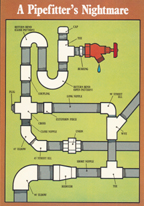
The category we call pipe fittings is probably the most complex of all plumbing categories. When you consider all the variables, including the piping material involved and the system of connection - all multiplied by the many configurations available - you've got a bunch of parts to learn about. Fortunately, basic configuration is what most fittings have in common, and that's what we'll focus on in this brief overview. As many specific options as there are, all pipe fittings fall within one of just five functional definitions:
Fittings That Extend Or Join A Pipe Line In The Same Direction
Coupling: The coupling is one of the simplest fittings used. In function, it is a sleeve used to join two sections of pipe or tube in a straight, in-line run. Here are the two variations available in this category:
- Conventional: By far the most common, this is a simple sleeve with a female opening at either end for connecting to the mating pipe ends.
- Extension Piece: In this case, the fitting has a female opening on one end, with a male connection on the other.
Nipple: Whereas most fittings are characterized as being basically female components to receive male pipe ends, nipples are short male pieces used to join with female components. Essentially, nipples are simply short pieces of pipe or tube. Though they can be made up on the job site in the same manner as the basic pipe itself, threaded nipples used in steel piping systems are commonly furnished in specific lengths, already threaded for installation. The numerous specific lengths of nipples fall within three general size categories:
- Close: This is the easiest to identify, not only because it is the shortest, but because it is the only type with threads across the entire length (threads from both ends meeting in the middle).
- Short (sometimes called "shoulder"): This term covers the intermediate lengths, and has a portion of plain, unthreaded surface between ends.
- Long: Obviously, this is a longer version of the short nipple.
Union: A union is a fitting used to permit a quick disconnection in a pipe line, or to make possible the final assembly of a piping run. In concept, a union is essentially a coupling that breaks in the middle, with the two ends being joined together by means of a threaded nut. Each end component has a female opening for connecting to a pipe end. The third part of the assembly is a threaded collar - a nut that draws the two ends together when tightened.

Fittings That Change The Direction Of A Pipe Line
Elbow: Also called by the nickname of "ell" or "L," this fitting provides an angled change in the direction of a piping run. Variations include:
- Regular Elbow: Like the coupling, a regular elbow has two female openings for connection to the adjoining pipe sections. Common angles of supply elbows are 90? and 45? (more variations within the DWV category).
- Street Ell: This variation is different than the regular elbow in that it has a female connection on one end, and a male connection on the other.
- Drop Ear Ell: This is essentially a regular elbow with short flanges (ears) extending from one end of the bend. Holes in the ears are used to secure the fitting to the wall framing, which in turn, makes the pipe run stable at that point.
Return Bend: This is a "U"-shaped fitting with female connections at both ends. Return bends are commonly available in three configurations, relating to the radius of the bend itself (the distance between the legs): Close, Medium and Open.
Fittings That Branch Off A Pipe Line
Tee: This is another fitting that pretty well describes itself. Shaped like the letter "T," it has two female connections in line with the primary pipe run, and a third female connection at a right angle out the side. One of the most commonly used fittings, the tee permits the creation of a branch line off a main pipe run.Wye: Same basic concept here as the "tee," except that the side outlet comes off the fitting at a 45? angle, rather than 90?. In appearance, it looks like the letter "Y," hence, the name.
Cross: This is like a "double tee" - permiting the creation of two branch lines off the single fitting which contains four female connections positioned at 90? angles to each other. Here again, the name describes the shape.
Fittings To Close Off An Opening
Plug: This part is designed to seal off a female opening in a piping system. An example of this would be a "tee" that is installed with a future branch in mind, but is needed to serve simply as a coupling for the present. Typically, plugs for threaded connections are furnished with a square head or square recess for turning (and the heads on certain larger sizes are sometimes hex shaped).
Cap: This is the female counterpart to the plug. Instead of mating with openings, caps are used to close off male components - pipe or nipple ends. In configuration, some caps are furnished with a square-head protrusion for turning, but more typically, they are furnished plain.
Fittings To Connect Pipe Sections Of Different Diameters (Reduce Or Enlarge)
In a purely functional sense, the fittings below fit the first definition -- they are used to extend or join a pipe line in the same direction. But unlike those that are used to join pipe sections of the same diameter, these are used to connect pipe sections of different diameters.Reducer: This is similar to the coupling in that it has two female connections for joining the related pipe ends. In this case, however, one female opening is always smaller than the other.
Bushing: Sometimes confused with the reducer because of its similar function, the bushing has one male connection and one female. Bushings are available in two basic configurations:
- Hex Bushing: This type has wrench flats on one end, and is used where it is not necessary for the part to be screwed flush with the mating female component.
- Face Bushing: On this type, the male threads run the entire length of the fitting. It is used where a flush fit is desired.
Most bushings are the "concentric" type, meaning that the smaller opening is in line with the male end (on the same center line). There is a specialty type called eccentric bushing in which the smaller opening is offset to one side, not in line with the center of the male diameter.
